Do the justices on the Kansas Supreme Court make new law? Yes, and here is an example. View below, or here at YouTube.
For more on this issue, see Kansas Supreme Court: Making law, part 2.

Do the justices on the Kansas Supreme Court make new law? Yes, and here is an example. View below, or here at YouTube.
For more on this issue, see Kansas Supreme Court: Making law, part 2.
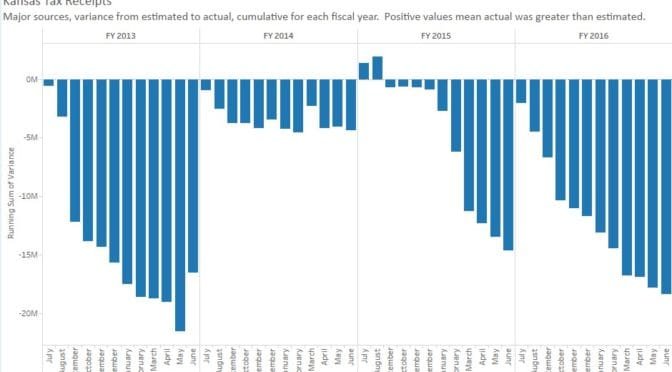
Kansas tax receipts by category, presented in an interactive visualization.
This visualization and article have been updated. Click here.
The Kansas Division of the Budget publishes monthly statistics regarding tax collections. These figures have been gathered and are presented in an interactive visualization. In the visualization, there are these available tabs:
Table.s: A table of data. For each month the two data items supplied by the state are the actual value and the estimated. This table also holds the computed variance, or difference, between the actual value and the estimated value. A positive number means the actual value was greater than the estimated value.
Collections: Shows monthly collections for each component. Because monthly numbers vary widely, this data is presented as the moving average of the previous 12 months.
Annual Change: Shows the change from the same month of the previous year. A positive value means the value for this month is greater than the same month last year.
Estimates: The Governor’s Consensus Revenue Estimating Working Group provides monthly estimates. This chart shows the variance, or difference, between the actual value and the estimated value. A positive number means the actual value was greater than the estimated value.
Running Total Estimates: This is the cumulative sum of the estimate variances, reset to zero at the start of each fiscal year (July 1).
Running Total Change from Prior Year: This is the cumulative sum of the monthly changes from the prior year, reset to zero at the start of each fiscal year (July 1).
For the past two years, individual income tax collections have been relatively flat. There are variations each month, but overall the trend is slightly up. Corporate income tax collections are on a slight downward trajectory.
Retail sales tax and compensating use tax have been mostly rising for two years. A higher sales tax rate took effect on July 1, 2015, with the rate rising from 6.15 percent to 6.50 percent.
Cigarette taxes have risen rapidly since July 2015 when higher tax rates on these products took effect. The same trend is present in the tobacco products tax.
Severance taxes — tax collected on natural gas and oil as it is extracted from the ground — have been on a downward trend as prices for these products have fallen. This is a sizable tax. In June 2014 collections of this tax were running at about $143 million per year. For September 2016, the rate is $22 million annually.
Click here to use the visualization.
Source of data is Kansas Division of the Budget.
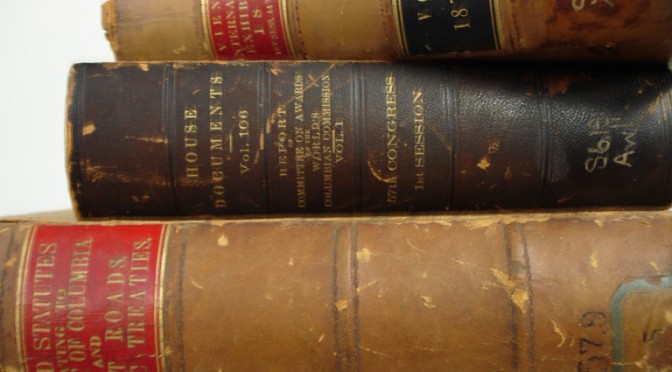
Appellate court judges make new law, and Kansas has the most elitist and least democratic supreme court selection system in the country.
What is the substantive difference between these two systems?
A) A state’s chief executive appoints a person to be a judge on the state’s highest court. Then the state’s senate confirms or rejects.
B) A nation’s chief executive appoints a person to be a judge on the nation’s highest court. Then the nation’s senate confirms or rejects.
Perhaps there is a difference that I’m not smart enough to see. I’m open to persuasion. Until then, I agree with KU Law Professor Stephen Ware and his 2007 analysis of the way Kansas selects Supreme Court judges as compared to the other states.1 That analysis concludes that “Kansas is the only state in the union that gives the members of its bar majority control over the selection of state supreme court justices.”
Ware has made other powerful arguments in favor of discarding the system Kansas uses: “In supreme court selection, the bar has more power in Kansas than in any other state. This extraordinary bar power gives Kansas the most elitist and least democratic supreme court selection system in the country. While members of the Kansas bar make several arguments in defense of the extraordinary powers they exercise under this system, these arguments rest on a one-sided view of the role of a judge.”2
Judges, Ware says, make law, and that is a political matter: “Non-lawyers who do not know that judges inevitably make law may believe that the role of a judge consists only of its professional/technical side and, therefore, believe that judges should be selected entirely on their professional competence and ethics and that assessments of these factors are best left to lawyers. In short, a lawyer who omits lawmaking from a published statement about the judicial role is furthering a misimpression that helps empower lawyers at the expense of non-lawyers, in violation of basic democratic equality, the principle of one-person, one-vote.”3

Superficially, it doesn’t seem to make sense for Kansas Democrats to oppose the governor making judicial selections while supporting the President of the United States having the same power. It does make sense, however, when we realize that Kansas Democrats are comfortable with the state’s bar selecting the judicial nominees that the governor may consider. (Which gives truly useful and enjoyable bars a bad name.) Lawyers, especially lawyers that take an active role in politics, tend to be Democrats, and progressive Democrats at that. If the Kansas bar was dominated by constitutional conservatives, would Kansas Democrats feel the same?
I’m not claiming that the motives of conservative Kansas Republicans are pure. Will they change their stance on the desirability of the governor appointing Supreme Court judges if there is a Democratic governor? I don’t know, but I have a suspicion.
Defenders of the current Kansas system claim that the system is based on merit, not politics. To which we must note that this year the Kansas Supreme Court was reversed by the United States Supreme Court. It wasn’t even close, with justices voting eight to zero that the Kansas court was wrong in its application of the law. (The other Supreme Court justice said “I do not believe these cases should ever have been reviewed by the Supreme Court.) If we’re relying on our state’s bar to select competent judges, we’re making a mistake.
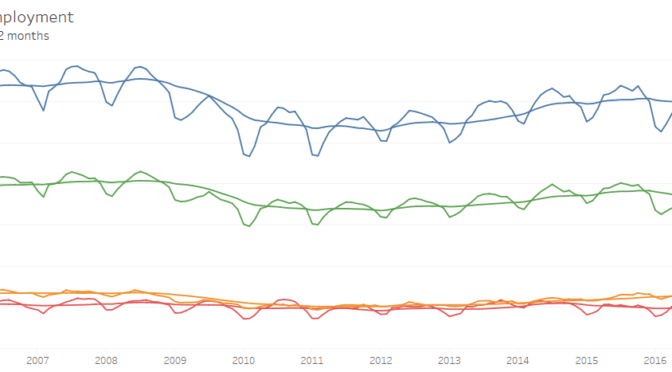
Tip to the Wichita Eagle editorial board: When a lobbying group feeds you statistics, try to learn what they really mean.
When investigating the claims of a lobbying group, Kansas Policy Institute found that the statistics — when examined closely — do not support the narrative the group promotes. Unfortunately, the Wichita Eagle editorial board did not examine the group’s claims closely enough to determine their validity.

At issue is the claim that transfers from the Kansas highway fund have lead to the loss of highway construction jobs. It’s repeated not only by the state’s highway construction lobbyists, but also by others. The statistics that are cited deserve further investigation, which is what KPI did on its article Media and highway contractors mislead again. KPI’s Dave Trabert found:
Had the Eagle bothered to examine Mr. Totten’s claim, they would have learned that only 2 percent of the construction job decline was attributable to highway construction and that the loss of 100 jobs is less than 1 percent of total highway jobs.
In addition to learning that Mr. Totten was grossly exaggerating, they would have learned that employment for construction of new homes and non-residential buildings showed very nice growth and the real problem is in specialty trade contractors for non-highway projects.
Trabert is referring to the Wichita Eagle editorial board citing figures from a self-interested lobbying group — in this case, Bob Totten, executive vice president of the Kansas Contractors Association — without investigating the true nature of the figures.

This data is available in an interactive visualization which you may access here. For more information on highway spending in Kansas, see Kansas highway spending.

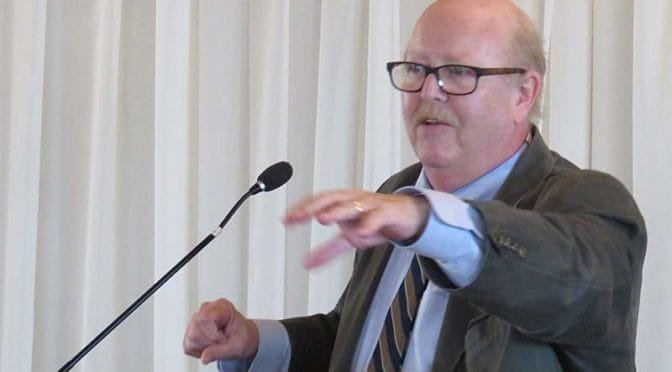
 From the Wichita Pachyderm Club this week: Martin Hawver briefed members and guests on the state of Kansas politics. Judge Phil Journey provided the introduction. Recorded August 19, 2016.
From the Wichita Pachyderm Club this week: Martin Hawver briefed members and guests on the state of Kansas politics. Judge Phil Journey provided the introduction. Recorded August 19, 2016.
Hawver is the dean of Kansas Statehouse press corps, having covered the beat longer than any current Statehouse reporter — first for 17 years as a Statehouse reporter for the Topeka Capital-Journal and since 1993 for Hawver’s Capitol Report, for which he is the primary reporter/writer. He also writes a column syndicated to Kansas newspapers, is interviewed about Kansas government and politics on TV and radio shows, and is a speaker for seminars and conventions.
Hawver’s Capitol Report is owned by Martin and his wife Vickie Griffith Hawver, who met and married while both worked at the Topeka Capital-Journal newspaper. Their website is havernews.com.

Kansas tax receipts by category, presented in an interactive visualization.
The Kansas Division of the Budget publishes monthly statistics regarding tax collections. These figures have been gathered and are presented in an interactive visualization.

Retail sales tax and compensating use tax have been rising for two years. A higher sales tax rate took effect on July 1, 2015, with the rate rising from 6.15 percent to 6.50 percent.
Cigarette taxes have risen rapidly since July 2015 when higher tax rates on these products took effect. The same trend is present in the tobacco products tax.
Severance taxes — tax collected on natural gas and oil as it is extracted from the ground — have been on a downward trend as prices for these produces have fallen. This is a sizable tax. In June 2014 collections of this tax were running at about $143 million per year. Two year later the rate is $28 million annually.
Click here for the most current version of the visualization.
Source of data is Kansas Division of the Budget.

Cutting spending for higher education, holding K through 12 public school spending steady, sweeping highway money to the general fund, reducing aid to local governments, spending down state reserves, and a huge projected budget gap. Who and when is the following newspaper report referencing?
Under _____ budget for fiscal _____, public schools would continue to receive $3,863 per student in state aid, and higher education would lose only $5 million in general tax dollars, mostly in the central Board of Regents office.
But _____ would take $165 million from highway projects and eliminate $86 million in aid to local governments — on top of the $95 million _____ withheld from highway projects and $48 million _____ kept from cities and counties.
_____ also made a campaign promise to build all projects promised under the state’s 10-year, $13.5 billion transportation program. _____ proposals didn’t say how the Department of Transportation would deal with the loss of funds.
_____ budget also would allow the Kansas Highway Patrol to hire 70 new troopers, give state employees a 1.5 percent pay raise, and prevent the closings of four minimum-security prison units and two inmate boot camps.
Under _____ proposals, total spending in fiscal _____ would decrease about $31 million, or 0.4 percent.
But that figure didn’t convey the seriousness of the state’s budget problems, which some officials have said are the worst since the Great Depression. The gap between expected general tax revenues and spending commitments during the next 18 months is more than $1 billion.
_____ also proposed to help eliminate the gap by spending some $313 million — all but $500,000 — that otherwise would be set aside as emergency cash reserves.
This is coverage from John Hanna of the State of the State Address from Governor Kathleen Sebelius in 2003, where she revealed plans for the fiscal 2004 budget. (Except the blank in “on top of the $95 million _____ withheld from highway projects” refers to her predecessor Bill Graves.) The original article is here.
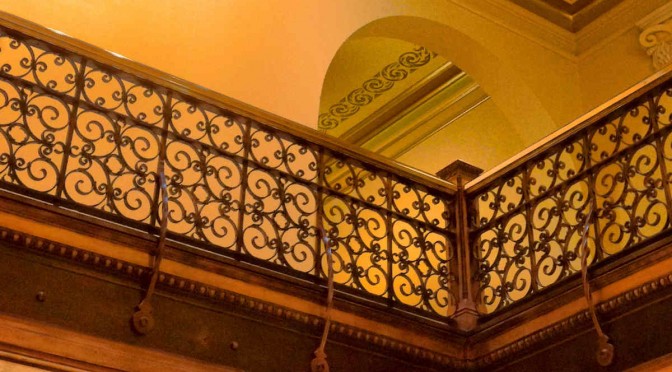
Jonathan Williams, Vice President in charge of the Center for State Fiscal Reform at the American Legislative Exchange Council (ALEC), addressed a luncheon gathering of the Wichita Pachyderm Club on July 22, 2016, presenting “A National Perspective on Kansas Fiscal Policy.” View below, or click here to view at YouTube. Videography by Paul Soutar.
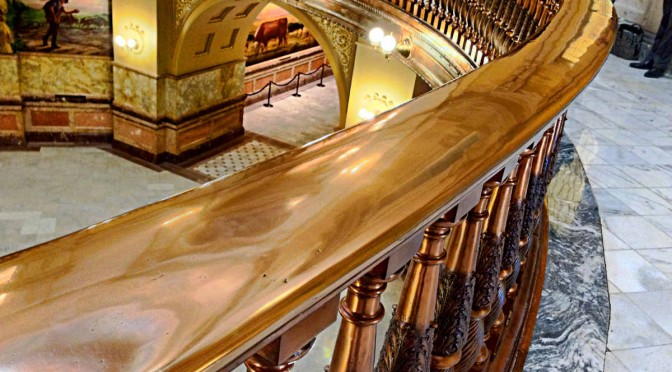
From the Wichita Pachyderm Club this week: Republican primary candidates for Kansas Senate were invited to participate in a forum. Candidates invited were:
This is an audio presentation recorded on July 15, 2016.